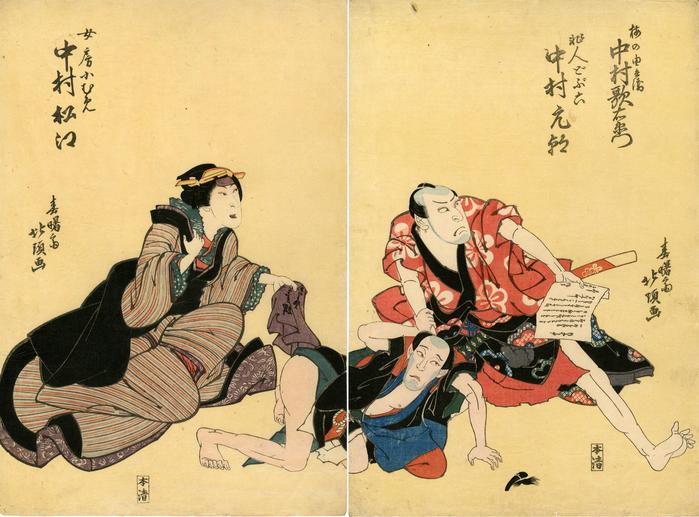Shunshosai Hokuchō (春曙斎北頂) (artist )
Two left panels of a yellow ground triptych - Nakamura Matsue III (中村松江) as the wife, nyōbō Komume (女房小むめ), Nakamura Ganchō I (中村元朝) as the hinin or outcast Doburoku (非人どぶ六) and Nakamura Utaemon III (中村歌右衛門) as Ume no Yoshibei (梅の由兵衛) in the play Suda no Haru Geisha Katagi (隅田春妓女容性)
09/1828
15 in x 10 in (Overall dimensions) color woodblock print
Signed: Shunshosai Hokuchō
春曙斎北頂画
Publisher: Honya Seishichi
(Marks 123 - seal 25-527
Waseda University - center panel
Waseda University - left panel
Museum für angewandte Kunst, Vienna - left panel
Hankyu Culture Foundation - right panel (actually the middle one)
Hankyu Culture Foundation - left panel
Hankyu Culture Foundation - the missing right hand panel
Philadelphia Museum of Art
Tokyo Fuji Art Museum The curatorial files of the museum in Vienna note: "The story of this piece is based on a true story and became the basis of several Kabuki and Bunraku plays. The play is about robbery, love and murder. Nakamura Matsue plays Komume, the wife of Yoshibei, who is to bring back a stolen treasure. Yoshibi [sic] kills Chōkichi, the brother of his wife, without knowing whom he has killed."
If you click on the image of these two panels and enlarge the image you will note that the onnagata is holding a cloth with something written on it. As yet we do not know the significance of this cloth nor what it is saying.
****
This commemorates a performance of Suda no Haru Geiko Katagi at the Naka Theater in 9/1828. This play was originally written by Namiki Gohei.
This is a particularly curious composition. Is it a triptych or a diptych. The placement of the figures in this piece in the Lyon Collection would suggest that it is a triptych. At the Hankyu Culture Foundation is a panel that is believed to be the right-hand panel. However, this raised more questions. First, this is supposed to represent a play that opened in 9/1828. Ebijūrō I died in 1827 and Ebijūrō II was not given that name until 11/1828, two months after the opening. Another thing is that Ebijūrō II died in his early twenties in 1829. The figure in the right-hand panel does not look that young. Hence, it must represent Ebijūrō I, but there is no way to know why.
We know from a Yoshitaki diptych at the Museum of Fine Arts in Boston that this play was still being performed in 1865.
Listed in Ikeda Bunko, Kamigata Yakusha-e Shusei (Collected Kamigata Actor Prints) Volume 2, Ikeda Bunko Library, Osaka 1998, no. 195. The whole triptych is illustrated on page 68.
This reference says the onnagata is 'Koume', but this may be a typo. The name is actually Komume.
Honya Seishichi (本屋清七) (publisher)
Nakamura Utaemon III (三代目中村歌右衛門) (actor)
Kyōto-Osaka prints (kamigata-e - 上方絵) (genre)
actor prints (yakusha-e - 役者絵) (genre)
Nakamura Matsue III (三代目中村松江) (actor)
Ume no Yoshibei (梅の由兵へ) (role)
Suda no Haru Geisha Katagi (隅田春妓女容性) (kabuki)
Namiki Gohei (初代並木五瓶) (kabuki)
Nakamura Ganchō I (中村元朝) (actor)
